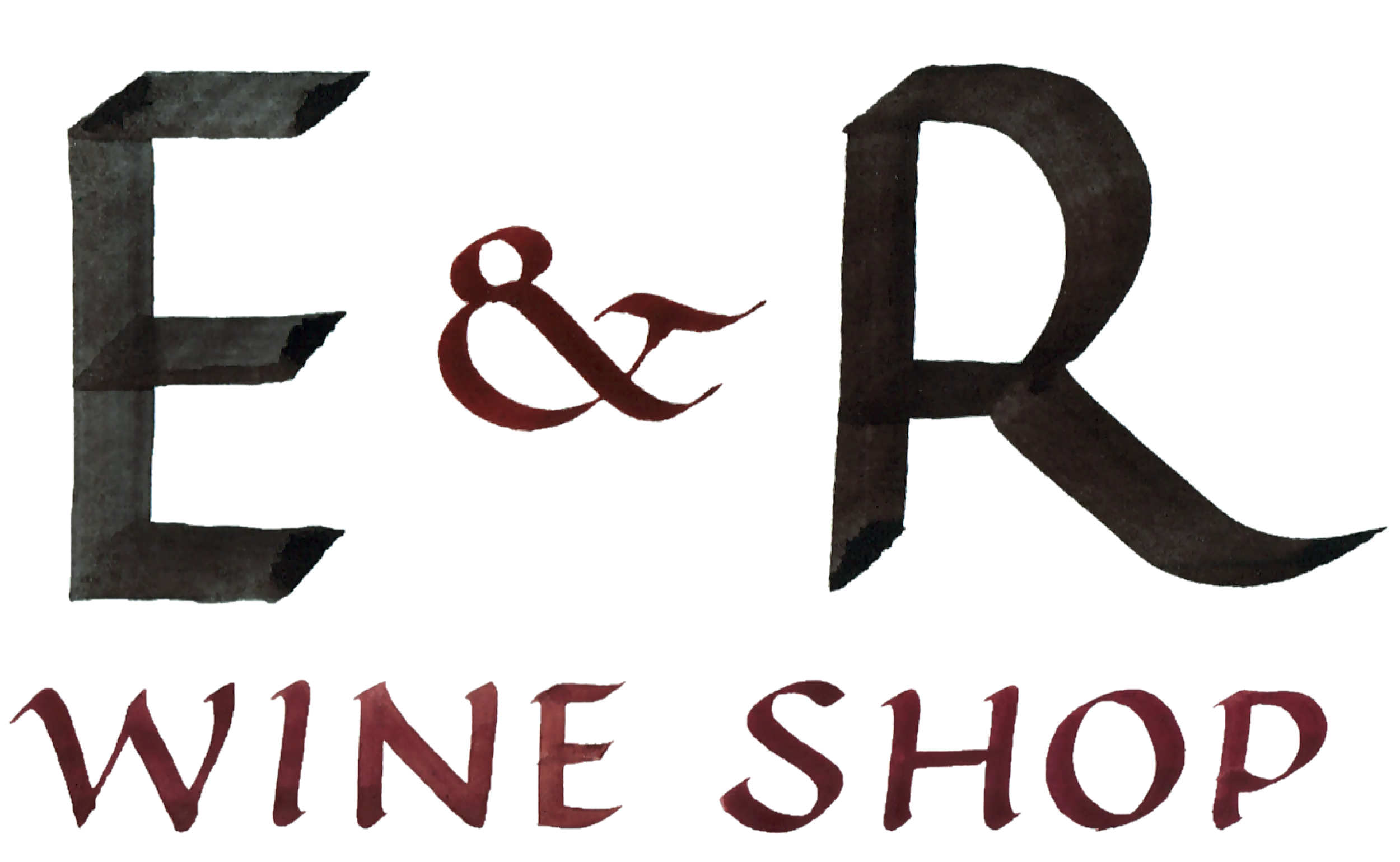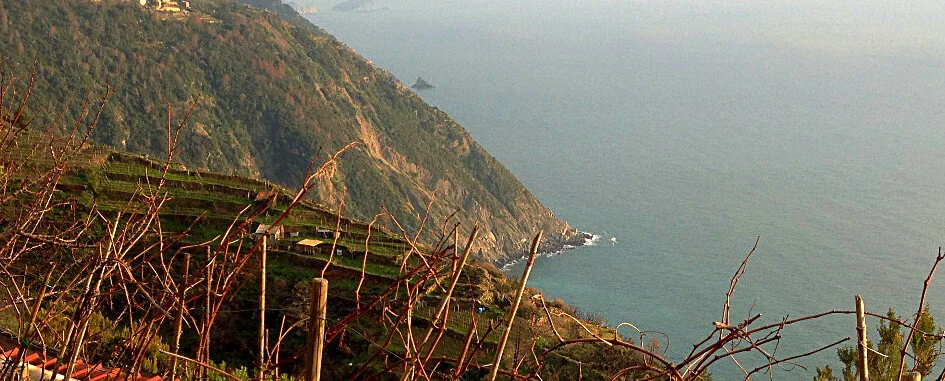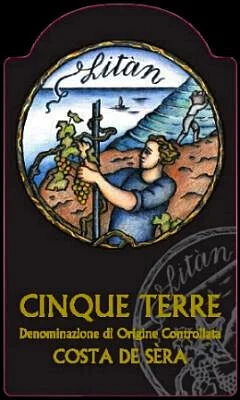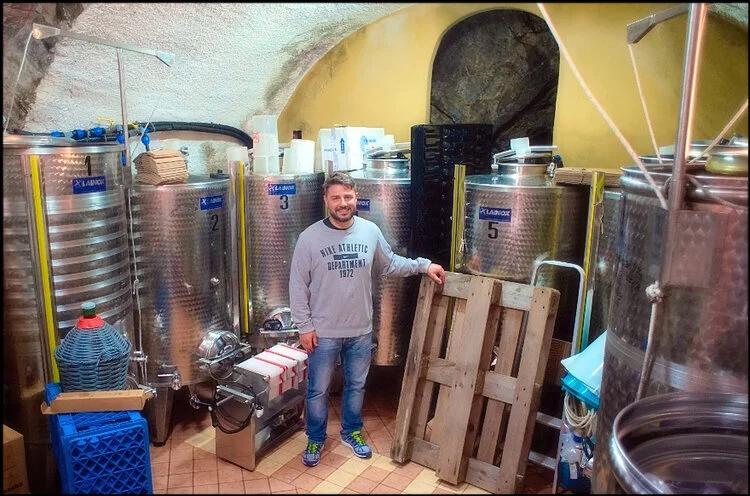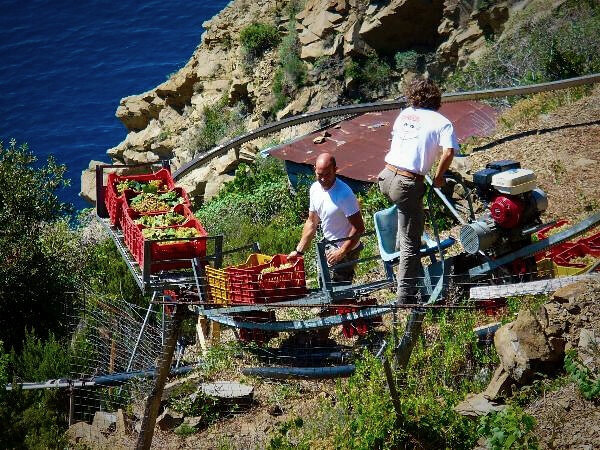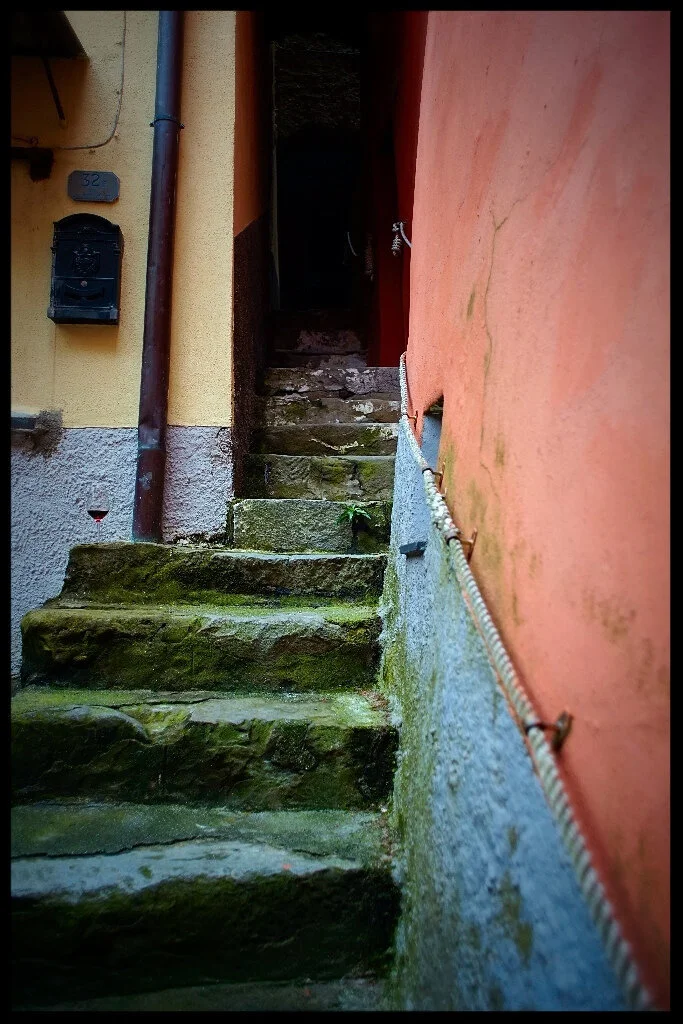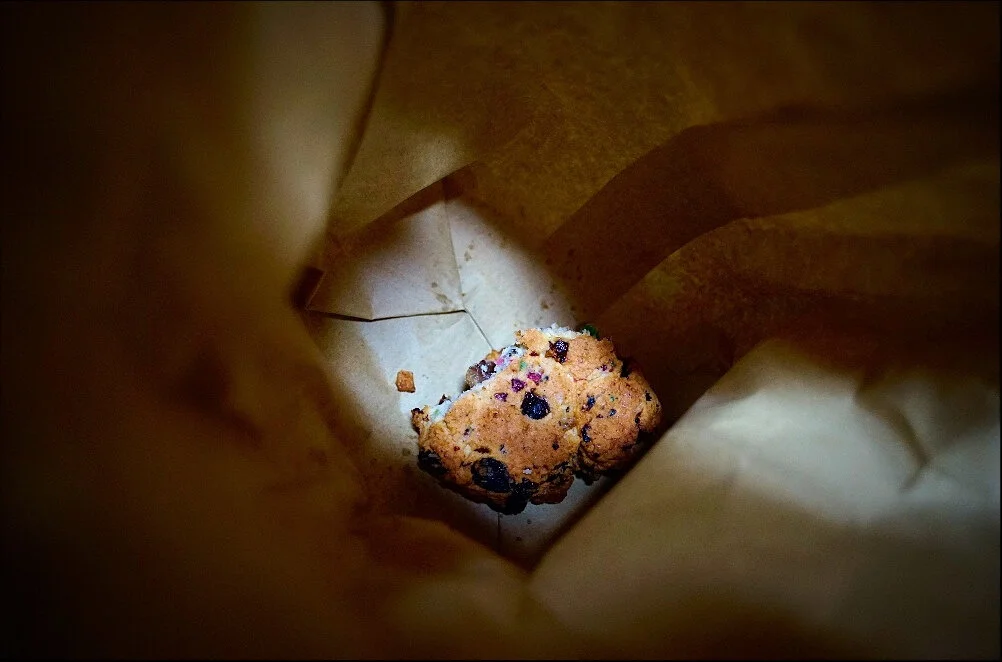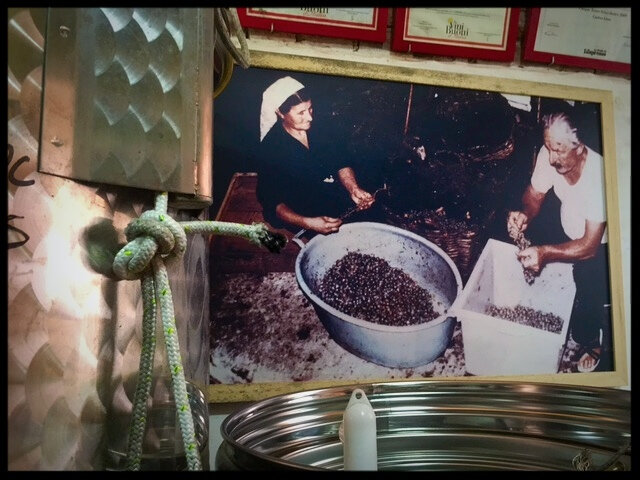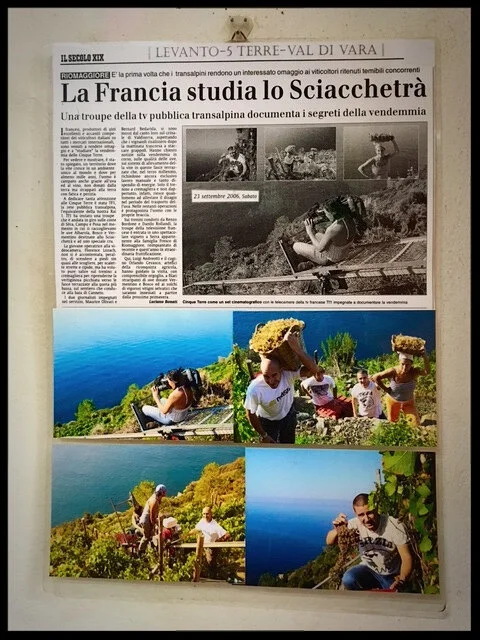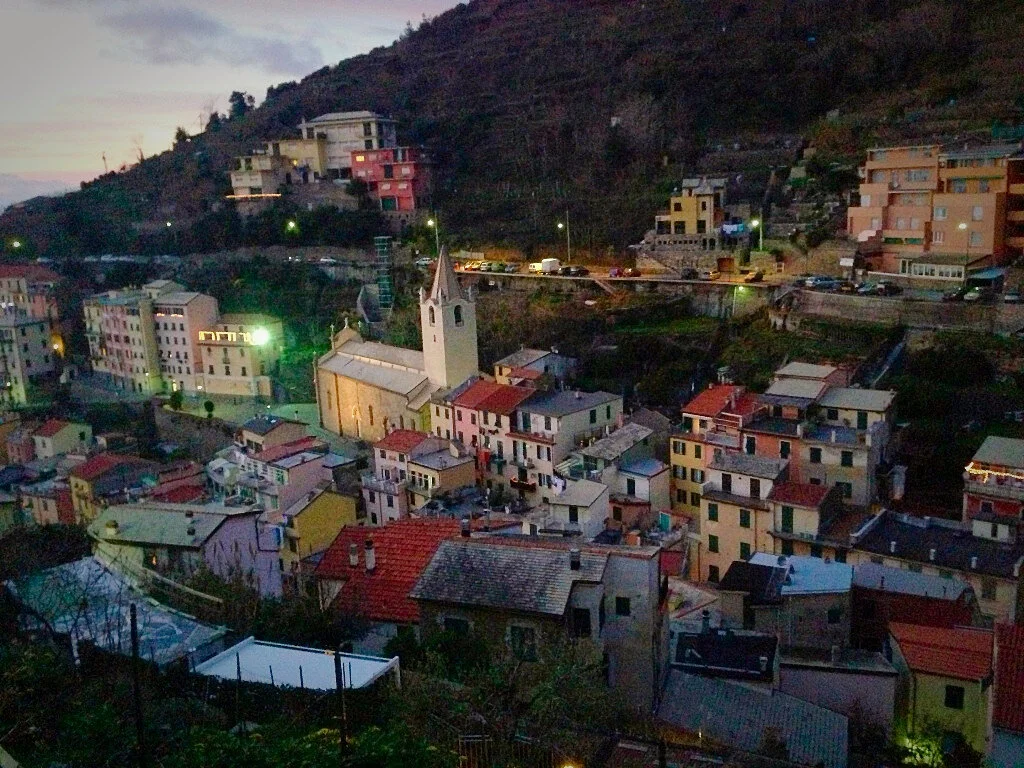Cantine Litan - Cinque Terre, Italy
(vines near riomaggiore, from our 2013 visit)
CINQUE TERRE: STONES INTO THE SEA
Editor's note: Our "almost direct imports" program carries on. (Yeah, we're nuts.) For the longest time hardly any wine from the Cinque Terre came to America - we've fallen in love the best of them. We love their purity and sense of place, their originality, their unique and complex flavors, their partnership with cuisine and the seemingly humble sensibility they possess - that is, the best of them do not feel like they are forcibly trying to convince your palate, but rather, it is as if they are trying to alert your taste buds about their character and their place of origin.
A while back, E&R became the first to bring to America the extraordinary wines of Cinque Terre's Samuele Heydi from his Azienda La Possa. We happily introduced new - very different, but as cool - wines in another USA Premiere from Cinque Terre's Cantine Litan. With these new wines we have added not one or two, but three brand new Cinque Terre winegrowers' sets of wines to E&R.
Why? Because they are great, they're original and each producer makes wines quite different from one another. Yet you can taste the sea and the stone in them all - and each is tempered by the ever present wind and a literal garden of herbs all around the terraced vines. The sea below vines echoes always in constant motion, often a harrowing vertical drop below the vines. The place lights up your insides somehow...
As a group, the four properties we are working with help portray truly heroic work managed 365 days a year under the most difficult circumstance in incredibly cramped, tiny, hard to get to places to grow grapes; cellars in little stone rooms often up flights of steps never intended for winemaking; and the process of harvesting, crushing, aging, and finally bottling, all in these cramped spaces to be able to send them out to sea and offer them to you.
Have we gone overboard? Yes, we have, and no, we haven't. And surely no more than our partners producing these special wines in Cinque Terre. Please join us supporting the absolute best of tiny Cinque Terre's modest, singular output!
Click to enlarge images
If you were planning to make wine, chances are it won't be in Cinque Terre (save 5 Lands for your vacation). And, chances are, if you worked in Cinque Terre vineyards, Geico wouldn't insure you - it's (not) what they do.
In our nine Cinque Terre visits, the vineyards' reckless beauty has always felt like a half step from a free fall death. That is, straight down treacherous slopes- tumbled like the so many stones into the sea. Too steep to work the vines! Pay attention there- it's what you do.
The work is tough and demanding, and so fiscally unrewarding that many 'a winemaker pulled up roots and said so long.
A few years back on a visit with our dear friend, the great and crazy Maestro Elio Altare, he was virtually in tears over the slow drying up of production and a kind of "standardization" of the Cinque Terre's wines. Crazy, because, at nearing seventy, he "retired" from making Barolo in Piedmont's hilltop enclave of La Morra --- and started a winery in Cinque Terre (!) arguably the most rugged, challenging terroir in Italy. That Elio...
CANTINE LITAN, DIGGING IN
Riomaggiore's small treasure, Cantine Litan, was founded in 2000 by two brothers, Francesco and Orlando Cevasco and their cousin Luigi Andreotti. Their collective passion was so strong they decided to take up the more than formidable work of resuscitating sectors of their family's long abandoned vineyards across steep hillsides on the Costa de Sera, one of Cinque Terre's three "crus".
In the early years of the last century, along with the advent of two World Wars, the local wine market dried up and no one could make a living. The overwhelming majority of grape growers, farmers and winemakers had little choice, and wholesale areas of vines were left to fend for themselves. (In fact, amazingly, the number of hectares in the entire Cinque Terre was at one time down to about 100. In acres that is 247, or the equivalent of less than a half of a square mile.) There at Riomaggiore, in an area Orlando, Francesco and Luigi fondly call their "garden" (giardino), in honor of grandfather Giulio, they began their work right in the middle of one of Italy's Parco Nazionales, a Unesco World Heritage site. What they've created is not your garden variety garden. The work, between clearing the land (all skinny terraces by and large), restoring and replanting local grapes like Bosco, Albarola and Vermentino, was backbreaking and dangerous. They were young (Francesco, for one, was just 20 years old) and ambitious, which is exactly the energy it took to plant 5,000 vines by hand. In 2006 they began a very small production, and team E&R first visited them in early 2013. Our last visit was a few months ago.
June 19, 2016 - the day we met with Francesco in his tiny cellar tucked within the maze of hillside buildings and narrow, spiraling staircases of Riomaggiore - was a sad day. You wouldn't know it from the peaceful silence of the morning, or the sun glistening off the piles of trash littered throughout the village– remnants of careless passerby's; leftovers from typical tourist activity of the night before. Francesco was in pain, and we could see it in his eyes. He couldn't take us to the vineyard... because there was nothing to see beyond the wreckage of the giant storm that barely preceded our arrival the day before. He tried to show us photos on his phone, but the damage was too fresh to hold the image on the screen for more than a few seconds. He winced as he told us he'd be surprised if they had any white grapes to harvest at all this year. It was devastating to witness.
Ironically, it was truly difficult to imagine even a minuscule yield from a rugged hectare's-worth of grapes fitting inside the space we were standing in. And we absolutely couldn't picture how they managed to get the grapes to the "crush pad" that fed into the cellar door - a tiny landing only accessible from a single side flanked by a staircase too narrow for two humans to fit on side by side.
Kendall Jackson or Mr. Two Buck Chuck won't be making their next fortunes here.
Within a short amount of time we understood the type of people we were dealing with. Moving on from the subject of natural disaster - a way of life in these parts, by the way - Francesco opened his white wine, "Costa de Sera" and offered us some fresh (still warm) focaccia from the focacceria of the locals. Things started looking up. And then we tasted the wine, and we knew exactly why we were there (although the focaccia alone would have been worth it, because they definitely don't make it like that in the good ol' U S of A!).
This was the real Cinque Terre. Like the focaccia, the wine was authentic, a small piece of something that existed in the past, before Cinque Terre became a "business" (as Francesco put it). And he was right - we witnessed it the night before when lubricated crowds overtook the village and we observed how nothing smelled, tasted or sounded like the actual place we were in. Over the last couple decades, the place has homogenized in order to cater to the massive influx of international tourists received 365 days a year by these five towns - some of the most photographed (and picturesque) villages in world. As a testament to the changes, even the physical landscape is suffering, as the hiking paths connecting three of the villages have been shut down due to damage from overuse. Many of the locals have moved out, electing to live in nearby La Spezia while renting their homes in Cinque Terre to tourists. Reflecting on a highly successful pizza place in La Spezia that has maintained the local traditions, recipes and wine, Francesco wonders if the five villages have evolved in the wrong direction. His point: perhaps the reason people come here is to experience the true place, culture and customs, rather than the watered down, commoditized version it's become (which has us rethinking the earlier KJ/2buckchuck comment).
So the Litan brothers/cousins try their best to honor the place by maintaining authenticity. In their minds, if you only have a single hectare and low yields (if any at all, depending on the damages of the season) due to some of the most extreme growing conditions in the world, you make sure it counts. And they do.
A blend of the local trio: Albarola and Vermentino with Bosco - "the real grape of Cinque Terre", says Francesco - firmly at its base, Costa de Sera (one of the three designated "crus" of Cinque Terre) is beguiling from the start. Visually, a shimmering gold in the glass leaps out aromatically in layered waves of fruits and stones and savory herbs and spice – everything from apricot, ginger, orange and lemon peel, jasmine, nuts, salt, earth, rock and sea. On the palate it is a glorious contradiction of a rich, waxy texture with a fresh and salty lightness alongside all the interweaving flavors.
Litan 2012 Cinque Terre Sciacchetra - extremely limited.
Say whaaaa?! Once you learn how it rolls off the tongue you will want to scream it from the mountain tops: SHOCK-A-TRAH! Not only is it one of the best words in the world of wine, it's also one of the most transcendent elixirs found inside a bottle...and it takes a H.E. double hockey stick amount of work to get it there. Sciacchetra is one of THE great treasures of Cinque Terre. Why? For one, no one/where does what it does better: turns tiny shriveled raisins into something so deep, complex, fresh and delicious that it washes away even the most adamant will-not-do-sweet-wine-no-never mantras. We've seen it happen many'a time. Folks return from a vacation in paradise and they come in or call (even from across the country) looking for that funny-worded sweet wine they had in Cinque Terre: "I don't normally like sweet wine, but O.M.G., do you have some of THIS?!"
It's a Cinque Terre grape-growing family pasttime and it's rare and getting rarer, because, as if it's not hard enough just to grow the grapes, but Sciacchetra also requires drying them down to raisins so that when pressed, months later (after a careful hand selection of strictly berries that did not acquire (the bad kind of) rot), they eek out a tiny fraction of the juice that was once inside. The golden nectar is then aged inside small chestnut barrels for a number of years before being syphoned into small bottles from which it can be savored and celebrated. Litan's is one of the best we've ever had: best Sciacchetra, best "straw wines" (the grapes are historically dried on straw mats), best sweet wines, period. All the layers of flavors trick you into thinking it could be savory, but it simultaneously awards your sweet receptors with the true sense of sweet they long for yet so often are deprived of in place of something not from nature. Flavors of caramel - salted, nuts, orange peel, dried apricot, real maple come to mind, but the experience of the flavor is really made most complete by the feel and the depth and the surprising zap of freshness. Authentic as authentic gets, which Francesco topped off by breaking out a paper bag with a beautiful traditional dried fruit scone. DO try this at home.
(SS, mostly)
Click on each wine for more detail.
